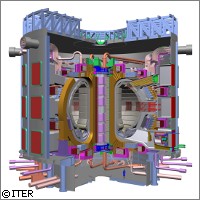ITER remote handling test platform inaugurated
A test platform for a remote handling system essential to the future functioning of the ITER fusion reactor has now been officially inaugurated in Tampere, Finland. The full-size test facility DTP2 (Divertor Test Platform for ITER) is said to be a significant step forward both for the international ITER project and for nuclear fusion research in general. The DTP2 facility will help to develop and test a remote handling system to change divertor cassettes. These cassettes are essential components of the ITER reactor: they are the only components allowed to touch the hot plasma inside the reactor in order to remove helium ash. Helium ash is a by-product of fusion reactions in deuterium-tritium plasma. The reaction produces energetic alpha-particles (helium nuclei), which heat the plasma. Once this has happened, they become helium ash, which needs to be removed from the plasma in order to prevent dilution. Each divertor cassette weighs nine tons, which makes handling them a challenge. In addition, 'operations need to be very accurate because the space is very limited,' said Dr Seppo Karttunen of VTT Technical Research Centre of Finland, which will be in charge of the facility together with Tampere University of Technology (TUT) and the Fusion for Energy (F4E) Joint Undertaking. At the moment, ideas as to how divertor maintenance might work are still in the researchers' heads. DTP2 will have to help verify whether ideas for cassette locking, cleaning and transportation are feasible. Ultimately, the researchers will devise a full maintenance cycle as well as tools and methods with the help of the test facility and virtual reality models. This will also make it possible to identify potential risks in the operation. 'This facility is ideal for training and knowledge transmission because it brings together a combination of technologies relevant to the ITER experiment. The know-how we have acquired will stimulate spin-offs in different innovation areas,' said Didier Gambler, director of the Fusion for Energy Joint Undertaking. The design and manufacture of DTP2 has taken four years and cost EUR 7 million. Half of the amount came out of the EU's Euratom programme. But this is only a drop in the ocean compared to the estimated EUR 5 billion or more that the ITER project is expected to require over the next 10 years.
Countries
Finland



